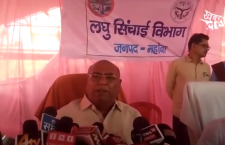Women, Virtue, Worship: The Idolization of Sati in Bundelkhand
From newly-wed bahus, to wee little girls, a lesson on the ideal wife, is being taught through insidious means (read: all in the name of faith) in the hinterland.
“It is a known fact that women get their hearts’ desires here, if they pray with true faith.”Phoolkali, who is visiting the Jarimata temple in Banda, a district in Bundelkhand, from Bargehni village, has, like everyone else around these parts, heard the story a million times since her childhood.Maya, head priestess, narrates it matter-of-factly, “She had a dream that her husband had died. Actually, she was at her mother’s place when she had the dream. She woke up in the middle of the night and declared that she must go back to Jari. That she must commit Sati.”
The “she” in the story is an unnamed woman known to have committed Sati in 1984 in Jari village of Banda. But “she” could be any woman, girl, really. After Rajasthan – home to the infamous RoopKanwar case of 1987 – it is Uttar Pradesh that has the maximum number of shrines and temples dedicated to Sati mata. And it is Uttar Pradesh, once again, that tops the list on crimes against women, according to the most recent NCRB data. It could be the practice of samjhauta wherein negotiations are conducted over dead bodies of murdered women, or it could be the intense deification of a violent practice – they are two sides of the same coin.
The Sati (Prevention) Act, 1988, declares the following as crimes – the voluntary or forced burning or burying alive of widows;the glorification of this action through the observance of any ceremony; the participation in any procession; the creation of a financial trust, the construction of a temple; any actions to commemorate or honor the memory of a widow who committed Sati.
But, in the badlands of Bundelkhand, one can be certain that if there is a regressive, shocking, violent practice against women, you are bound to find it here – not simply existing, but thriving.
At the Jari temple in Jari village in the BadokharKhurd block of Banda district in Bundelkhand, U.P., the flurry of devotional activity ranges from the common “naariyal-chadhaava” to the more devi-customized offering of “sindoor and bangles”. There are also twice-a-day special artis that see the keenest of devotees. Making goddesses out of mere mortal women is serious business here. Phoolkali is an annual visitor of the temple and the “mela” that springs up around it, “I bring bangles and sindoor. It is a known fact that women get their hearts’ desires here, if they pray with true faith.” Her fellow Bargehni-dweller Rani, meanwhile, indulges in some time-travelling and speaks of how the woman had waved to everyone from the pyre, minutes before she turned to ashes. When we ask her if she had been present then, she nods vaguely, pulling tighter the pallu around her head. Rani is among thousands of women who come to Jari every year. At a distance of 70 kms from the district headquarters in Banda, the concrete structure in Jari looks like any other temple in the area, but only until you step inside. Against a raised platform meant to symbolise the holy pyre is the photograph of Javitri. The fresh red tika on the monochrome picture makes Javitri almost come alive in the small space of the temple. Shri Sati Javitri Mata, 11.07.1979, it says, an eerie reminder of the date of her death. Placed next to that are photographs of her husband, other family members (all male), and various gods and goddesses.
Maya, unlike Rani, confirms her presence during the 1984 Sati, “Yes, I remember… She sat down right here”, she says, waving at the pedestal-like structure that women perform their perambulations around, “She placed her husband’s body in her lap. And the fire lit on its own. She became a Sati.” It was not long ago, we learn, when the district administration even organised special transport for worshippers at Jari.
These are not isolated cases. The reported Sati cases in Bundelkhand are mind-boggling in terms of both frequency and their self-perpetuating mythopoeia. In 1994, a case of Sati was reported from Chaudhury village in Banda; in 1999, a woman called Charan from Satpura in Mahoba allegedly committed Sati; in 2002, came the case of Kattubai in Panna. The last known reported case dates back to 2005 in Bahundari village, where a 70-year-old woman by the name of Ramkumari is said to have committed suicide. Ramkumari is a known legend around these parts. “Her face had gained an ethereal glow,” “We tried to stop her, but the minute we touched her, we got an electric shock,” being just some of the comments we’ve encountered when locals have described her “pure” act of suicide.
It is when we meet Ranjana, a moody teenager hanging around Jari with her mother, that we truly understand what Uma Kushwaha, local activist, had underlined, “This is nothing but a form of collective murder. The woman is cornered into it, pressured… Coconuts are thrown at her, people start chanting her name as Sati, an entire village turns against her… What is she supposed to do in such a situation?” Ranjana is coaxed into saying to us how noble it all was, how godly it all is – she looks unconvinced, but she is surrounded by a sea of women who are all channelling the Sati spirit, in true Bundeli fashion.
As BalKisan, a local resident says, all sombre, “Aastha hai (It’s called faith).”
As reported to Pooja Pande by Kavita and Meera Devi of Khabar Lahariya
This video report, alongwith an edited version of this article, first appeared on Scroll.

